人教版(2019)必修 第二册Unit 2 Wildlife protection Reading and thinking课件(共21张PPT 内嵌视频)
文档属性
| 名称 | 人教版(2019)必修 第二册Unit 2 Wildlife protection Reading and thinking课件(共21张PPT 内嵌视频) |
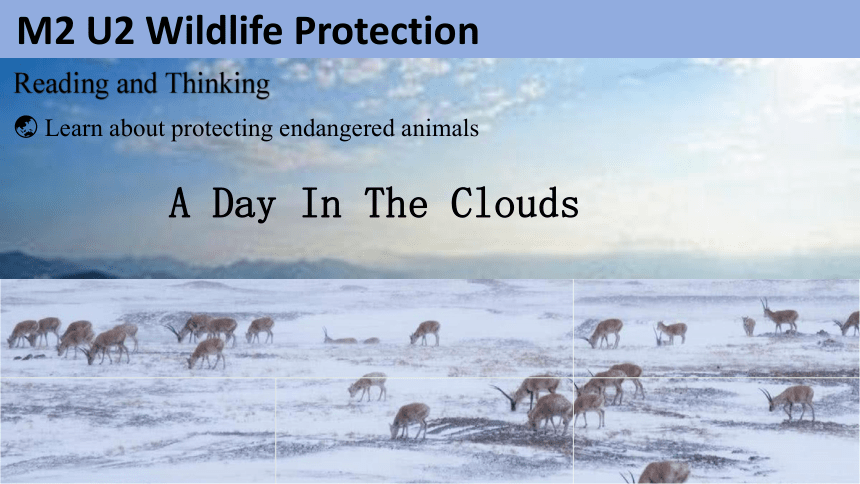
|
|
| 格式 | pptx | ||
| 文件大小 | 41.9MB | ||
| 资源类型 | 教案 | ||
| 版本资源 | 人教版(2019) | ||
| 科目 | 英语 | ||
| 更新时间 | 2023-12-26 11:55:24 | ||
图片预览

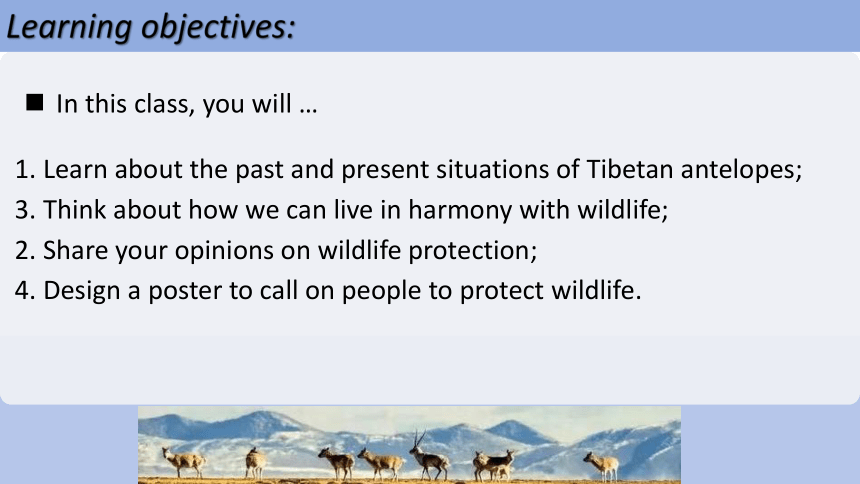
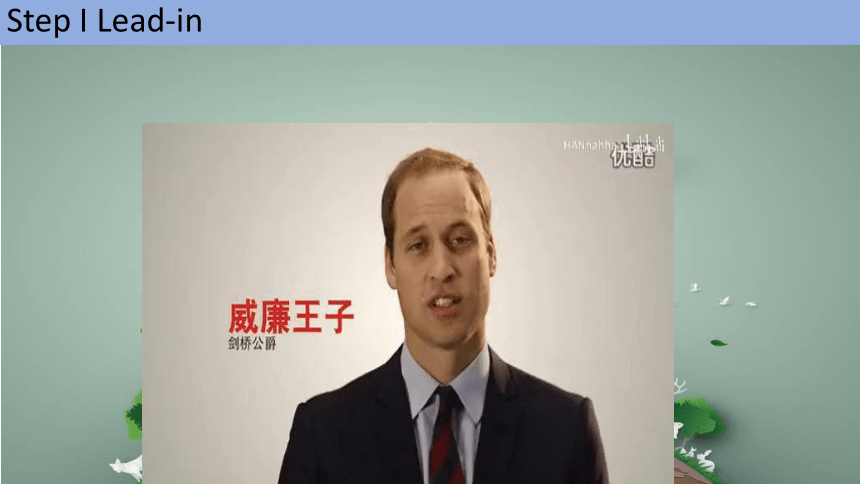
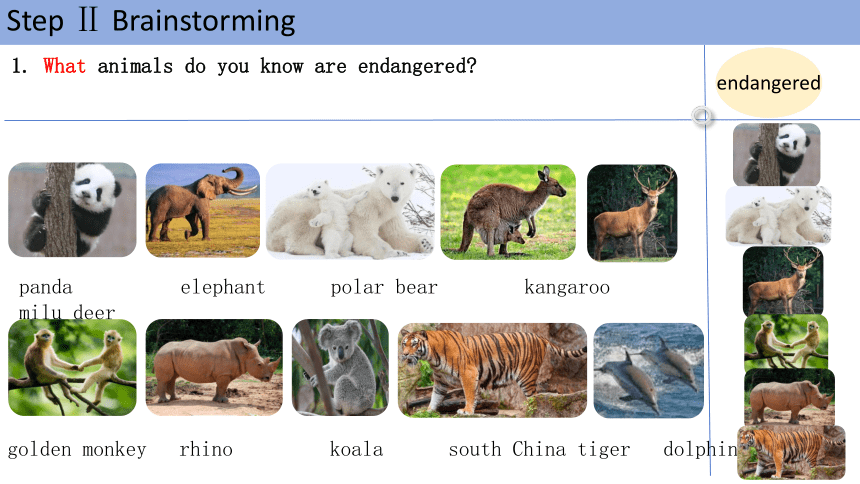
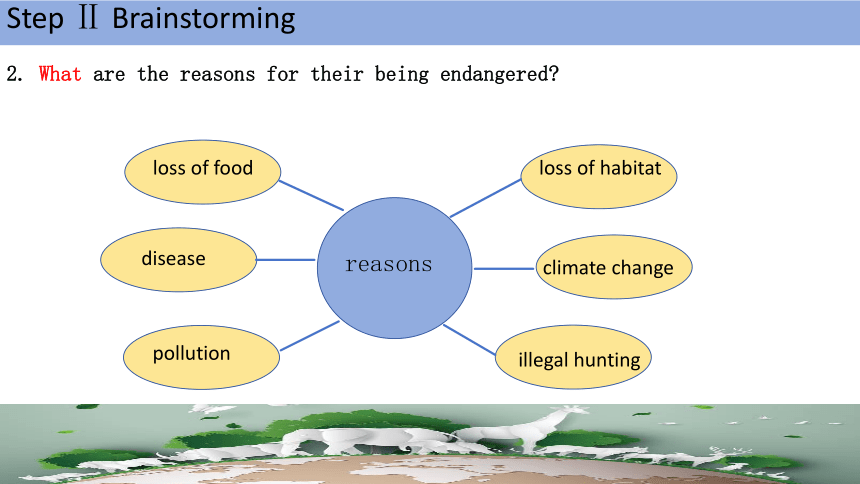
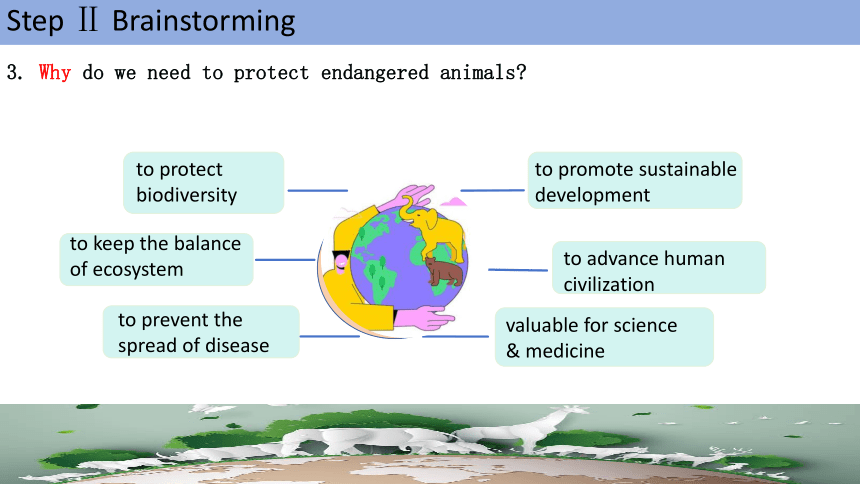
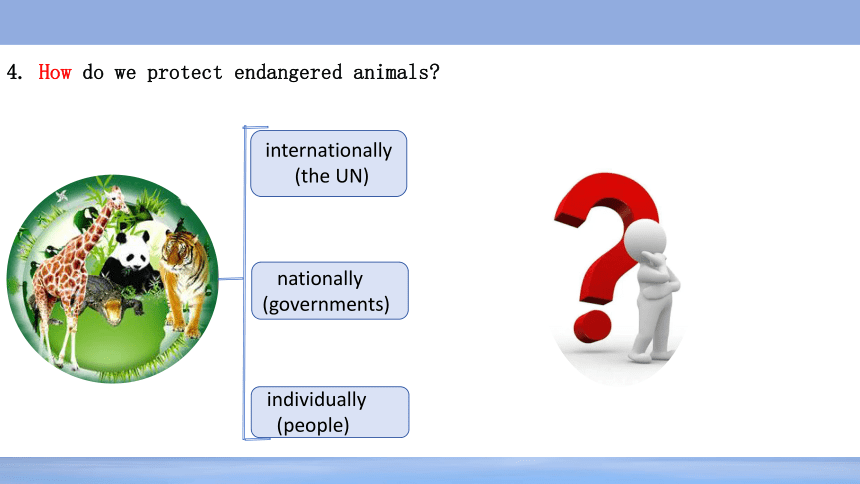
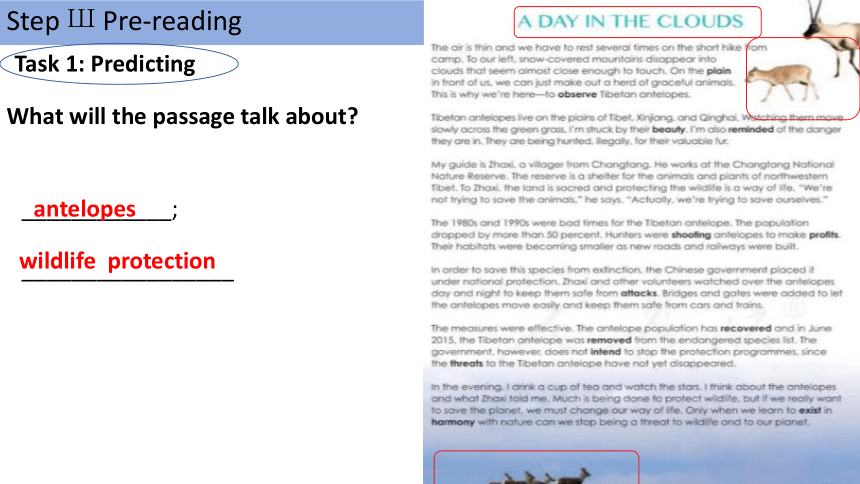
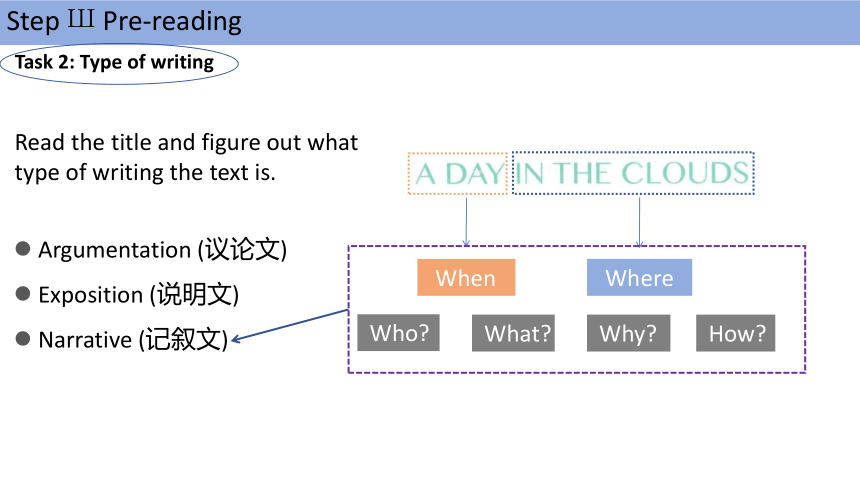
文档简介
(共21张PPT)
M2 U2 Wildlife Protection
A Day In The Clouds
Reading and Thinking
Learn about protecting endangered animals
Learning objectives:
In this class, you will …
1. Learn about the past and present situations of Tibetan antelopes;
3. Think about how we can live in harmony with wildlife;
2. Share your opinions on wildlife protection;
4. Design a poster to call on people to protect wildlife.
Step I Lead-in
Step Ⅱ Brainstorming
1. What animals do you know are endangered
panda elephant polar bear kangaroo milu deer
golden monkey rhino koala south China tiger dolphin
endangered
2. What are the reasons for their being endangered
disease
pollution
loss of food
loss of habitat
climate change
illegal hunting
reasons
Step Ⅱ Brainstorming
3. Why do we need to protect endangered animals
to keep the balance of ecosystem
to prevent the spread of disease
to protect biodiversity
to promote sustainable development
to advance human civilization
valuable for science & medicine
Step Ⅱ Brainstorming
4. How do we protect endangered animals
internationally
(the UN)
nationally
(governments)
individually
(people)
What will the passage talk about
____________;
_________________
antelopes
wildlife protection
Step Ш Pre-reading
Task 1: Predicting
Read the title and figure out what type of writing the text is.
Argumentation (议论文)
Exposition (说明文)
Narrative (记叙文)
When
Where
What
Who
Why
Step Ш Pre-reading
Task 2: Type of writing
How
Part 1 (Para. __)
Part 2 (Para._____)
Part 3 (Para. __)
1
7
2--6
Introduction: why inTibet
to __________________.
Body: what the writer
____________.
Ending: what the writer _____.
observe Tibetan antelopes
sees and hears
thinks
Task 3: Reading for structure
Step Ⅳ While-reading
Step Ⅳ While-reading
Task 4: Reading for main ideas
Read the passage and find out the main idea of each paragraph.
Paragraph 1: ___________________________________________________________
Paragraph 2: ___________________________________________________________
Paragraph 3: The guide thinks that __________________________________________
Paragraph 4: ____________________________________________________________
Paragraph 5: ____________________________________________________________
Paragraph 6: ____________________________________________________________
Paragraph 7: ____________________________________________________________
The writer visited Changtang in order to observe Tibetan antelopes.
Human beings must change the way of life in order to save the planet.
Tibetan antelopes are in danger.
the land is sacred and protecting the wildlife is
a way of life.
Bad times for the Tibetan antelopes.
The Chinese government and volunteers took measures to protect the Tibetan antelopes.
The effective measures have helped the population of Tibetan antelopes recover.
Step Ⅳ While-reading
Task 5: Reading for details
Read para 1、2 and complete the chart.
Place What the writer sees
to the left
_____________________________
______________________________
on the plain
__________________________
snow-covered moutains
clouds almost close enough to touch
a herd of graceful antelopes
Step Ⅳ While-reading
Task 5: Reading for details
Read para 4--6 and complete the chart.
Time What happened to antelopes Why/ How
1980s & 1990s _________________________
hunters______________________
habitats______________________
2015 population _________________; the antelope ________________ the government ______________
volunteers __________________
bridges and gates ______________
the population dropped by
more than 50 percent
were shooting antelopes
were becoming smaller
recovered
placed it under national protection
watched over the antelopes day and night
were added
was removed from the endangered species list
Step Ⅳ While-reading
Task 6: Reading and thinking
● Although the Tibetan antelope has been removed from endangered species list,
the government does not intend to stop the protection programmes. Why
Share your opinions:
Critical thinking
humans’ constant efforts
appeal for people’s awareness
respect nature
maintain a balance between
development and preservation
object to killling wild animals
national laws/ regulations
youth’s participation
● What would we need (to do)
purpose
I: May I ask you some questions
A: Of course.
I: What was life for antelopes like in the 1980s and 1990s
A: ___________________________________________________________.
I: What do you think of life now
A: Quite good. Life has changed greatly. _______________________.
Dialogue structure:
Step Ⅴ Post-reading
Task 7: Role play-interview
A=antelope; I=interviewer
(include what animal/why/how/appeal)
Step Ⅴ Post-reading
Task 8: Design a wildlife protection poster
groups 1--4
groups 5--8
groups 9--12
Sentence structures for reference:
what animal:
There are many endangered wild animals all over the world, such as ...
... are in danger of dying out, because ...
why:
Animals are our friends. ...
So protecting wild animals is very important for ...
how:
For example, we can ...
Besides, we should (not) ...
appeal:
I call on everyone to ...
It is high time we took measures to ...
Option 2:
Design a court debate between wildlife and humans.
Option 1:
Finish exercise 3 in the textbook.
Step Ⅵ Assignment
Be the change that you wish to see in the world. -Mahatma Gandhi
To save the animals is to save ourselves!
“Clear waters and green mountains are as valuable as mountains of gold and silver.”
Thank you!
M2 U2 Wildlife Protection
A Day In The Clouds
Reading and Thinking
Learn about protecting endangered animals
Learning objectives:
In this class, you will …
1. Learn about the past and present situations of Tibetan antelopes;
3. Think about how we can live in harmony with wildlife;
2. Share your opinions on wildlife protection;
4. Design a poster to call on people to protect wildlife.
Step I Lead-in
Step Ⅱ Brainstorming
1. What animals do you know are endangered
panda elephant polar bear kangaroo milu deer
golden monkey rhino koala south China tiger dolphin
endangered
2. What are the reasons for their being endangered
disease
pollution
loss of food
loss of habitat
climate change
illegal hunting
reasons
Step Ⅱ Brainstorming
3. Why do we need to protect endangered animals
to keep the balance of ecosystem
to prevent the spread of disease
to protect biodiversity
to promote sustainable development
to advance human civilization
valuable for science & medicine
Step Ⅱ Brainstorming
4. How do we protect endangered animals
internationally
(the UN)
nationally
(governments)
individually
(people)
What will the passage talk about
____________;
_________________
antelopes
wildlife protection
Step Ш Pre-reading
Task 1: Predicting
Read the title and figure out what type of writing the text is.
Argumentation (议论文)
Exposition (说明文)
Narrative (记叙文)
When
Where
What
Who
Why
Step Ш Pre-reading
Task 2: Type of writing
How
Part 1 (Para. __)
Part 2 (Para._____)
Part 3 (Para. __)
1
7
2--6
Introduction: why inTibet
to __________________.
Body: what the writer
____________.
Ending: what the writer _____.
observe Tibetan antelopes
sees and hears
thinks
Task 3: Reading for structure
Step Ⅳ While-reading
Step Ⅳ While-reading
Task 4: Reading for main ideas
Read the passage and find out the main idea of each paragraph.
Paragraph 1: ___________________________________________________________
Paragraph 2: ___________________________________________________________
Paragraph 3: The guide thinks that __________________________________________
Paragraph 4: ____________________________________________________________
Paragraph 5: ____________________________________________________________
Paragraph 6: ____________________________________________________________
Paragraph 7: ____________________________________________________________
The writer visited Changtang in order to observe Tibetan antelopes.
Human beings must change the way of life in order to save the planet.
Tibetan antelopes are in danger.
the land is sacred and protecting the wildlife is
a way of life.
Bad times for the Tibetan antelopes.
The Chinese government and volunteers took measures to protect the Tibetan antelopes.
The effective measures have helped the population of Tibetan antelopes recover.
Step Ⅳ While-reading
Task 5: Reading for details
Read para 1、2 and complete the chart.
Place What the writer sees
to the left
_____________________________
______________________________
on the plain
__________________________
snow-covered moutains
clouds almost close enough to touch
a herd of graceful antelopes
Step Ⅳ While-reading
Task 5: Reading for details
Read para 4--6 and complete the chart.
Time What happened to antelopes Why/ How
1980s & 1990s _________________________
hunters______________________
habitats______________________
2015 population _________________; the antelope ________________ the government ______________
volunteers __________________
bridges and gates ______________
the population dropped by
more than 50 percent
were shooting antelopes
were becoming smaller
recovered
placed it under national protection
watched over the antelopes day and night
were added
was removed from the endangered species list
Step Ⅳ While-reading
Task 6: Reading and thinking
● Although the Tibetan antelope has been removed from endangered species list,
the government does not intend to stop the protection programmes. Why
Share your opinions:
Critical thinking
humans’ constant efforts
appeal for people’s awareness
respect nature
maintain a balance between
development and preservation
object to killling wild animals
national laws/ regulations
youth’s participation
● What would we need (to do)
purpose
I: May I ask you some questions
A: Of course.
I: What was life for antelopes like in the 1980s and 1990s
A: ___________________________________________________________.
I: What do you think of life now
A: Quite good. Life has changed greatly. _______________________.
Dialogue structure:
Step Ⅴ Post-reading
Task 7: Role play-interview
A=antelope; I=interviewer
(include what animal/why/how/appeal)
Step Ⅴ Post-reading
Task 8: Design a wildlife protection poster
groups 1--4
groups 5--8
groups 9--12
Sentence structures for reference:
what animal:
There are many endangered wild animals all over the world, such as ...
... are in danger of dying out, because ...
why:
Animals are our friends. ...
So protecting wild animals is very important for ...
how:
For example, we can ...
Besides, we should (not) ...
appeal:
I call on everyone to ...
It is high time we took measures to ...
Option 2:
Design a court debate between wildlife and humans.
Option 1:
Finish exercise 3 in the textbook.
Step Ⅵ Assignment
Be the change that you wish to see in the world. -Mahatma Gandhi
To save the animals is to save ourselves!
“Clear waters and green mountains are as valuable as mountains of gold and silver.”
Thank you!
